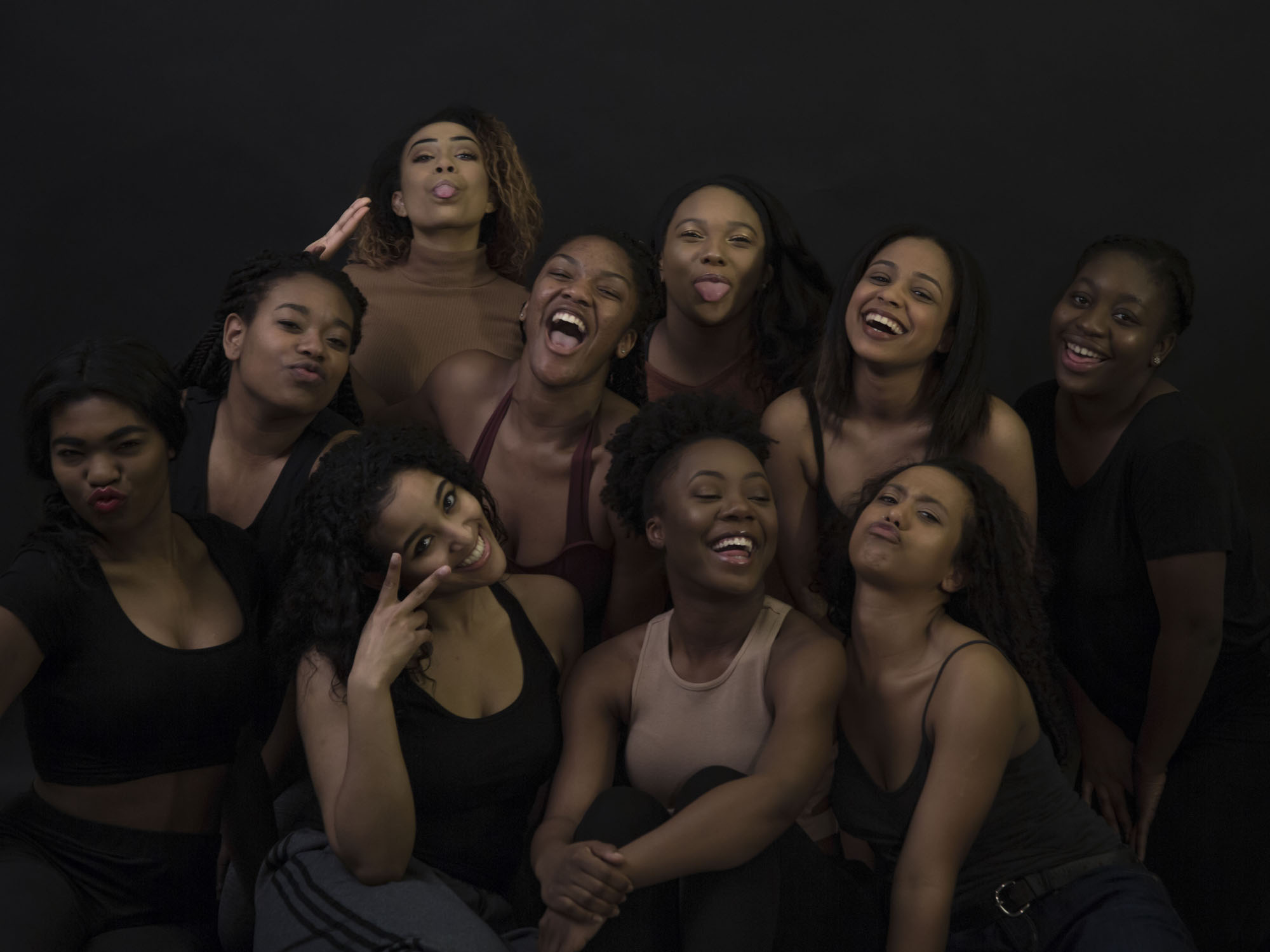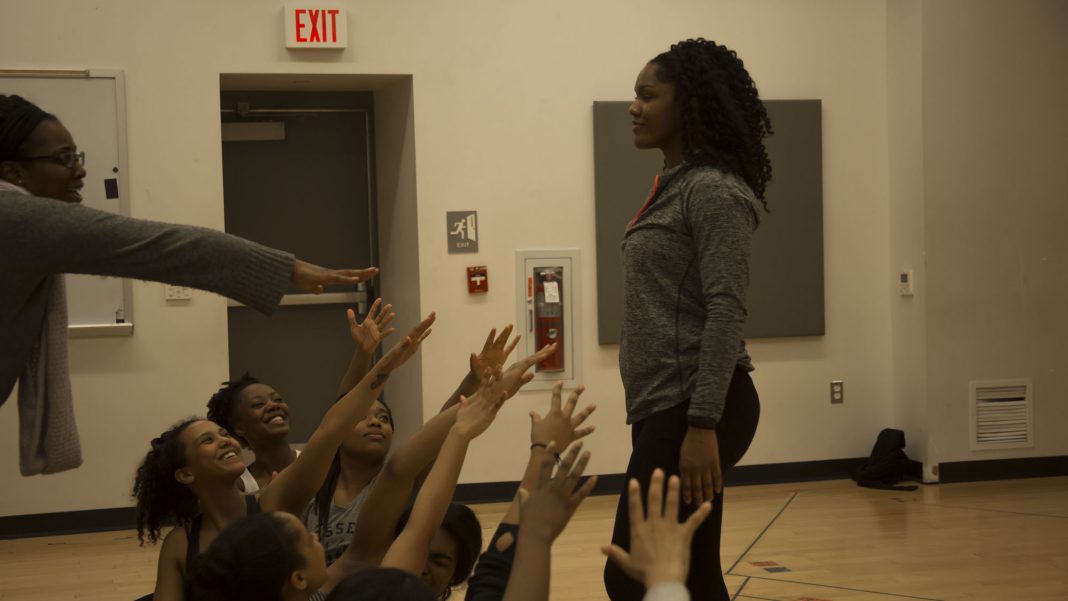Before I even walk into the room, I’m hooked. Spellbound. The driving beat of a drum rises through the wooden doors of the Rehearsal House, accompanied by a chorus of soaring voices that drowns out the steady pattering of raindrops on the roof. The voices intertwine and harmonize, creating and overturning beautiful chords that emanate life. When they suddenly stop, I take a chance and crack open the door, slipping into the room only to find that the source of the powerful music was not some immense choir, but a group of ten girls sitting on the floor in a circle.
This was my first glimpse of Ntozake Shange’s for colored girls who have considered suicide/when the rainbow is enuf. Directed by theatre professor Dr. Sharrell Luckett, the show will mark the final mainstage of the 2017-2018 academic year when it hits the Baker Theatre stage from Apr. 26 to 28. The show has been highly anticipated on campus since it was announced, and for good reason — though I only witnessed a bit of the rehearsal process, the sheer range of talents required to put it on and the impeccable application of those talents was certainly a wonder to behold.
Prior to watching this rehearsal, I had believed that for colored girls… was simply a play consisting of monologues. Though monologues are indeed heavily used throughout the show, for colored girls… is much more than a play. As Asia DeShields ‘19, who portrays the Lady in Green, explains, Shange’s piece ties together so many elements that the playwright had to invent a new word in order to fully describe it.
“for colored girls who have considered suicide/when the rainbow is enuf is a choreopoem,” said DeShields. “In a series of poems, monologues, dances and songs, the piece expresses the experiences of seven different black women who are assigned colors rather than names. They are the Lady in Red, Lady in Orange, Lady in Yellow, Lady in Green, Lady in Blue, Lady in Purple and the Lady in Brown. The stories that these women get to tell are not always necessarily their own but speak to many shared experiences of black women. Major themes that are explored within this work are love, loss, sisterhood, diasporic identity, bliss, sorrow and artistry.”
Originally performed on Broadway in 1976, the choreopoem consists of 20 individual works written by Shange. Each of the seven leads performs a few of the poems, sometimes taking on the entire piece alone and sometimes trading off with the other women. Consistently, though, the members of the company make themselves known, reacting to the stories that the women tell or dancing and singing together to the beat of the drum. As Destiny Snipe ‘18, the Lady in Yellow, giggles and grinds whilst recreating a tale of first love on graduation night, the ensemble crowds around her, watching with wide eyes and bright smiles. They squeal in delight as Snipe expertly raises the story’s stakes, making eye contact with an audience that will soon be present and treating them, too, as exclusive recipients of this private tale, the kind that might be told in the early hours of the morning at a slumber party.

The choreopoem does not simply evoke this sense of inclusion on the level of audience-character interaction — in its mere existence, it is a force of inclusion on a much broader, more fundamental level. Cameron Silliman ‘18, who plays the Lady in Red, describes how the show’s presence on the grounds of a primarily white institution adds to its significance.
“This show gives the opportunity for black actresses of Muhlenberg to truly show their strengths as performers,” Silliman said. “It gives me and the rest of the cast the ability to tell our stories the way that we want them to; we have complete agency over how these experiences are shared. It has also given me the opportunity to perform an experience that I can directly relate to, something that I have never been given to chance to do on this campus.”
By allowing black actresses and a largely black creative team to take ownership over the stories that concern them, a space is created for those who share the identities celebrated in the show to truly be themselves. Without the essentializing force of tokenization or poor research, equipped with a script that allows for black feminine subjectivity to live and thrive in all of its complexity, for colored girls… gives Muhlenberg’s black actresses a rare opportunity to take on roles genuinely written for them, for black girls who are human and very, very real.
Beyond Snipe’s initially lighthearted story, the choreopoem approaches such multifaceted issues as sexual assault, bringing the oft unseen black female experience starkly into the light. This idea is shared by DeShields, whose initial response to the work was charged with emotion.
“This show is so special to me. The first time I read the play, I was personally going through a hard time, and the script brought me to tears, especially the line at the end: ‘I found God in myself, and I loved her fiercely,’” said DeShields. “This show is for survivors. [It shows] the struggle and pain that black women collectively have had to overcome in a society that was never made for us to succeed in, and we are still here thriving and creating, and finding more love in ourselves each and every day. black women deserve all the love and happiness the universe has to offer, and I am honored to have the opportunity to give a voice to these narratives. And getting to make art with all black women has been such a privilege! I have so much love and admiration for my cast.”
By allowing black actresses and a largely black creative team to take ownership over the stories that concern them, a space is created for those who share the identities celebrated in the show to truly be themselves.
Still, as Silliman asserts, the show certainly does not contain messages that only apply to black women.
“This in an opportunity for audience members to listen, celebrate and cry with us,” Silliman said. “While we are specifically talking about black women and our stories, these experiences are also universal and relatable in certain ways. This show can be eye opening in terms of broadening people’s understandings or changing misunderstandings of what it means to be a black woman.”
In the Rehearsal House, the cast members begin a fresh run-through. The seven leads walk up to microphone stands, breathing deeply and experimentally moving as though the metal rods were their partners in a music-less dance. Gabi Hines ‘18 eventually steps forward, commanding the stage with breathtaking presence, and begins the first monologue. “She’s half notes scattered without rhythm,” Hines says. “Sing a song of her possibilities … Let her be born!”
The entire ensemble erupts in a song and dance of unapologetic volume and joy, running faster and slower in time with the speed of the drum. Snipe talks of sex, Krystal Hall ‘21 touts the virtues of Spanish dances, Silliman falls to the ground in tears after breaking up with her partner, the veins in her neck pronounced in passion, only to be lifted up by the black women around her, Green and Yellow and Blue and so many more. As it turns out, only the rainbow is enuf.






















